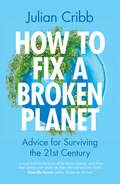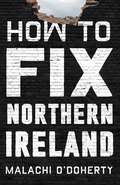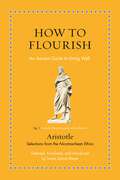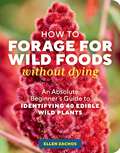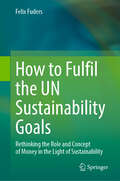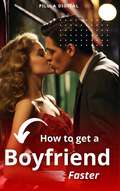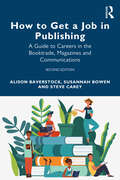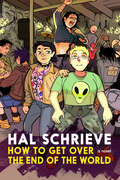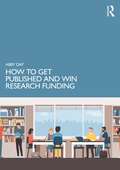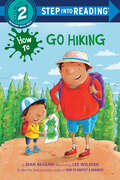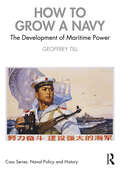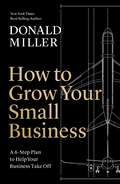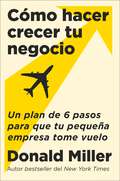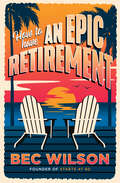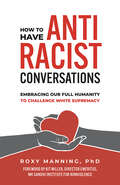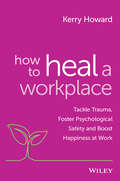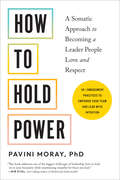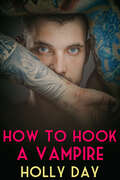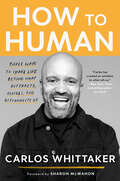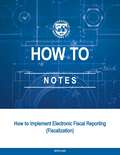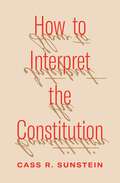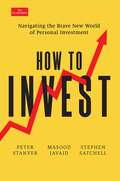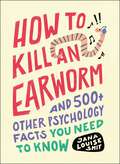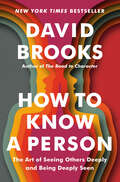- Table View
- List View
How to Fix a Broken Planet: Advice for Surviving the 21st Century
by Julian CribbDo you want to help save human civilisation? If so, this book is for you. How to Fix a Broken Planet describes the ten catastrophic risks that menace human civilisation and our planet, and what we can all do to overcome or mitigate them. It explains what must be done globally to avert each megathreat, and what each of us can do in our own lives to help preserve a habitable world. It offers the first truly integrated world plan-of-action for a more sustainable human society - and fresh hope. A must-read for anyone seeking sound practical advice on what citizens, governments, companies, and community groups can do to safeguard our future.
How to Fix Northern Ireland
by Malachi O'DohertyA highly topical and original investigation into the sectarian divide in Northern Ireland, published to coincide with the 25th anniversary of the Good Friday agreement.In this thought-provoking and engaging book, Malachi O'Doherty argues that division in Northern Ireland is fundamentally not about whether the country should be governed as part of Ireland or as part of Britain - as presumed by the Good Friday Agreement - but rather is entirely sectarian, an inter-ethnic stress comparable to racism.Part memoir, part history and part polemic, How to Fix Northern Ireland shows how the split between catholics and protestants infests everyday life - from education and segregated housing, from street protests, bonfires and parades to the high politics of power sharing and Brexit - and asks what can be done to solve a centuries-old social rift and heal the relationship at the heart of the problem.
How to Flourish: An Ancient Guide to Living Well (Ancient Wisdom For Modern Readers Ser.)
by AristotleAristotle’s essential guide to human flourishing—the Nicomachean Ethics—in a lively new abridged translationAristotle’s Nicomachean Ethics is one of the greatest guides to human flourishing ever written, but its length and style have left many readers languishing. How to Flourish is a carefully abridged version of the entire work in a highly readable and colloquial new translation by Susan Sauvé Meyer that makes Aristotle’s timeless insights about how to lead a good life more engaging and accessible than ever before.For Aristotle, flourishing involves becoming a good person through practice, and having a life of the mind. To that end, he draws vivid portraits of virtuous and vicious characters and offers sound practical advice about everything from eating and drinking to managing money, controlling anger, getting along with others, and telling jokes. He also distinguishes different kinds of wisdom that are essential to flourishing and offers an unusual perspective on how to appreciate our place in the universe and our relation to the divine.Omitting Aristotle’s digressions and repetitions and overly technical passages, How to Flourish provides connecting commentary that allows readers to follow the continuous line of his thought; it also features the original Greek on facing pages. The result is an inviting and lively version of an essential work about how to flourish and lead a good life.
How to Forage for Wild Foods without Dying: An Absolute Beginner's Guide to Identifying 40 Edible Wild Plants
by Ellen ZachosThis on-the-go guide is perfect for new foragers eager to learn about the edible plants they're most likely to find, no matter what region they're in, and provides photos and easy-to-follow identification and use guidelines for the 40 most common—and most delicious—wild plants.How to Forage for Wild Foods without Dying is a book for anyone who likes to go on nature walks and would like to learn about the edible plants they&’re most likely to come across—no matter what region they&’re in. Author Ellen Zachos shares her considerable expertise, acquired over decades of foraging in every part of North America. She offers clear, concise descriptions of edible wild plants, in addition to any potential lookalikes, as well as critical information about proper harvesting, processing, and cooking. Zachos has curated the plant selection to include only the 40 most common, most delicious edible plants, ranging from black walnuts and juniper berries to elderflowers, burdock, fiddlehead ferns, lambsquarter, wild garlic, sunchokes, and many more. With Zachos&’s expert advice and easy-to-follow guidelines, readers will be confident in identifying which plants they can safely eat and which ones they should definitely avoid. Easy instructions for preparation and eating for maximum enjoyment are included.
How to Fulfil the UN Sustainability Goals: Rethinking the Role and Concept of Money in the Light of Sustainability
by Felix FudersThis book combines the field of economics —especially monetary theory— with other disciplines like ecology, physics, humanities, social sciences and development theory. This transdisciplinary approach makes the book a unique contribution for researchers, students, policy makers and professionals working in governmental or nongovernmental institutions, as well as anyone interested in society’s well-being and achieving a true social-ecological transformation. It is written in an accessible language in order to reach a broad audience. In 2015, more than 190 world leaders recognized that the world is on a “collision course” (Max-Neef) and committed to 17 Sustainable Development Goals (SDGs). Many conferences and high-level meetings have been held since then, and one of the most frequently discussed topics is how to finance these goals. There is a widespread belief that coming up with more money for sustainable development will “do the trick”. Usually, the discussions focus on finding additional financial resources in order to achieve the goals faster. In this book it is argued that not only is more money needed, but it needs to be a different kind of money. The book demonstrates that ALL but one of the SDGs are directly linked to our monetary system, which —being completely unnatural— can be seen as the most important, but at the same time least recognized, reason for market failure. Many people think we just need to do more, faster, better. Very few say that we have done things fundamentally wrong and that the institutions and values which motivated us to do those things need to be changed. It will be concluded that only if we change our unnatural design of money to a more natural one, will we be able to reach these goals
How to get a Boyfriend Faster
by Pílula DigitalThere are some ATTITUDES that keep you away from the person you WANT to date. It is IMPORTANT to pay attention to certain points, otherwise, the chance you have of WINNING your loved one will go down the drain. Whether you are DATING or not, your attitudes REVEAL a lot about your BEHAVIOR and SHOW who you are. Therefore, it is NECESSARY to be careful if you REALLY want to KEEP the love of your life by your side, or even find someone WHO LOVES YOU. Good reading!
How to Get a Job in Publishing: A Guide to Careers in the Booktrade, Magazines and Communications
by Alison Baverstock Susannah Bowen Steve CareySo you’ve always dreamed of a career in publishing… but you don’t know where to start or how? You’re holding the key in your hands! Using insider information, How to Get A Job in Publishing is the newly revised edition of the classic text for you if you are keen to work in publishing or associated industries – or if you are already in publishing and want to go further. Packed with real-life quotes, case studies and practical advice from publishing veterans, and more recent arrivals, the authors differentiate types of publishing and explain how roles and departments work together. They discuss the pros and cons of internships and further study as well as training and lifelong learning, working internationally, networking and building your personal brand. The book includes vital guidelines for applying for publishing roles, including sample CVs and cover letters and a glossary of industry terms, to make sure you stand out from the crowd when you apply for jobs. This thoroughly updated edition covers: • The post-pandemic publishing world, changes and current controversies, the rise of e-books, Amazon, self-publishing and indie publishing. • The growth in tertiary courses in Publishing Studies and internships – are they really the best way in? • How to create your CV and a compelling cover letter that gets you noticed. A new chapter addresses equity, diversity, inclusion and belonging, reflecting on the current state of the publishing industry, how to evaluate potential employers and how to look after yourself and others at work. Whether you are a new or soon-to-be graduate of Media and Publishing, or are just interested in a career in publishing or the creative industries, How to Get A Job in Publishing is an essential resource.
How to Get over the End of the World: A Novel
by Hal SchrieveBoldly weird, cool, and confident, this YA novel of LGBTQ+ teen artists, activists, and telepathic visionaries offers hope against climate and community destruction. From the National Book Award–longlisted author of Out of Salem.James Goldberg, self-described neurotic goth gay transsexual stoner, is a senior in high school, and fully over it. He mostly ignores his classes at Cow Pie High, instead focusing on fundraising for the near-bankrupt local LGBTQ+ youth support group, Compton House, and attending punk shows with his friend-crush Ian and best friend Opal. But when James falls in love with Orsino, a homeschooled trans boy with telepathic powers and visions of the future, he wonders if the scope of what he believes possible is too small. Orsino, meanwhile, hopes that in James he has finally found someone who will be able to share the apocalyptic visions he has had to keep to himself, and better understand the powers they hold.How to Get over the End of the World confirms Hal Schrieve as a unique and to-be-celebrated voice in LGBTQ+ YA fiction with this multi-voiced story about flawed people trying their hardest to make a better world, about the beauty and craziness of hope, about too-big dreams and reality checks, and about the ways in which human messiness—egos, jealousy, insecurity—and good faith can coexist. It also about preserving the ties within a chosen family—and maybe saving the world—through love, art, and acts of resistance.
How to Get Published and Win Research Funding
by Abby DayMost journal articles and research proposals are rejected. That represents a waste of everyone’s time, energy, and spirit, especially now when, more than ever, academic careers are precarious. In this practical book, Professor Abby Day addresses these two inter-related and most challenging areas for academics and researchers in their professional careers: how to secure research funding and how to get research published. Reviewers, unpaid and often unappreciated, are over-stretched with their regular academic jobs, and increasingly reluctant to spend time reading poorly constructed papers or proposals. As fewer reviewers are available, the waiting time for a decision increases. Everyone loses. It doesn’t have to be like that. Professor Day’s ground-breaking strategy covers both publishing and funding challenges in similar, yet distinct ways. Lack of time? Conflicting priorities? No idea where to start or what matters most? This book explains how to overcome these and other common obstacles to successful publication and funding. For the first time, one book covers both activities, with practical guidance for setting your strategy and purpose, identifying the right publisher or funder, and understanding your audience and the key criteria for success, as well as helpful advice for writing and managing the challenges of an academic career. This book draws on the first and second editions of two international bestsellers, How to Get Research Published in Journals and Winning Research Funding. Based on original research with editors, funders, and successful academics, plus two decades of running international workshops on publishing and funding, Professor Day has now updated and merged these two critically acclaimed texts. This book is essential reading for graduate students and early career faculty members, who will gain new and effective insights and strategies to secure funding and publication opportunities to help develop their academic careers.
How to Go Hiking (Step into Reading)
by Jean ReaganLet's take a hike! Enjoy the view in this Step 2 early reader from the New York Times-bestselling creators of How to Babysit a Grandpa.New hiking boots call for a hiking adventure! Pack your backpack with snacks, water, and a map, and join an uncle and his nephew as they head out for their trip, but this time, the kids lead the way! This Step Into Reading story embraces the highs and lows of a hike in the woods--from spying lizards, to getting a blister--and of coming home again.Step 2 readers use basic vocabulary and short sentences to tell simple stories. They are perfect for children who recognize familiar words and can sound out new words with help.
How to Grow a Navy: The Development of Maritime Power (Cass Series: Naval Policy and History)
by Geoffrey TillThis book examines the large but neglected topic of the development of maritime power from both an historical and a contemporary point of view. Navies have never been more important than they are now, in a century becoming, as widely expected, increasingly and profoundly maritime. The growing competition between China and Russia with the United States and its allies and partners around the world is essentially sea-based. The sea is also central to the world's globalised trading system and to its environmental health. Most current crises are either sea-based or have a critical maritime element to them. What happens at sea will help shape our future. Against that background, this book uses both history and contemporary events to analyse how maritime power and naval strength has been, and is being, developed. In a reader-friendly way, it seeks to show what has worked and what has not, and to uncover the recurring patterns in maritime and naval development which explain past, present and future success - and failure. It reflects on the historical experience of all navies, but in particular it poses the question of whether China is following the same pattern of naval development illustrated by Britain at the start of the 18th century, which led to two centuries of naval dominance. This book will be of much interest to students of maritime power, naval studies, and strategic studies, as well as to naval professionals around the world.
How to Grow Your Small Business: A 6-Step Plan to Help Your Business Take Off
by Donald MillerThe Wall Street Journal BestsellerFor so many entrepreneurs, running a small business ended up looking different than they imagined. They&’re stressed, discouraged, and not confident in their plan for growth. In How to Grow Your Small Business, Donald Miller gives entrepreneurs a 6-step plan to grow their businesses so they produce dependable, predictable results.Using the exact steps you&’ll learn in this book, Donald Miller grew his small business from four employees working out of a basement to a 15 million dollar operation, increasing revenue sixfold in just six years. As Miller grew his own business from the ground up, he realized nobody had put together a simple, step-by-step playbook for growing a business. That book didn&’t exist. Until now.In this book, you&’ll learn the 6 steps to grow a successful small business and create a playbook to implement them- your Flight Plan. When you have a completed Flight Plan in hand, you can stop drowning in the details and spend more time doing the things you truly love- in your business and your life.In How to Grow Your Small Business, you&’ll learn how to:Cast a vision for your company that includes three economic prioritiesClarify your marketing messageInstall a sales framework that makes your customers the heroOptimize your product offeringRun a management and productivity playbook that aligns your entire team.Use 5 checking accounts to manage your cash flowIf you&’re ready to experience freedom, flexibility, and growth for your business, How to Grow Your Small Business is the book you&’ve been waiting for.
How to Grow Your Small Business \ Cómo hacer crecer tu negocio (Sp. ed.): Un plan de 6 pasos para que tu pequeña empresa tome vuelo
by Donald Miller«Si buscabas un plan sencillo y probado para hacer crecer tu negocio, ahora lo tienes en tus manos». —LEWIS HOWES, autor de La escuela de la grandezaBestseller del Wall Street Journal.Dirigir un negocio suele alejarse mucho de lo que nos imaginamos al emprender. Creemos que lo más difícil es dar el primer paso y empezar a vender, pero nadie nos advierte que la mayoría de las pequeñas empresas quiebra por no saber gestionar ese crecimiento. Si tu negocio te pide a gritos un plan para crecer de manera segura y confiable, pero no sabes por dónde comenzar, llegaste al lugar indicado.Cómo hacer crecer tu negocio es un sencillo manual de 6 pasos que te ayudará a profesionalizar tu operación y aumentar tus ganancias e ingresos, sin importar el tipo o el tamaño de tu compañía. Diseñado y probado por el exitoso empresario y autor bestseller Donald Miller, este novedoso sistema hará que tu empresa tome vuelo, y que tú ganes dinero, tranquilidad y tiempo para dedicarte a lo que realmente te gusta.Aquí aprenderás sobre:Liderazgo: cómo crear y ejecutar un plan de crecimiento fácil y confiable.Marketing: cómo atraer, expandir y mantener tu base creciente de clientes ideales.Ventas: cómo dejar de vender e invitar a los clientes a formar parte de una historia.Optimización del producto: tácticas para identificar áreas en las que puedes aumentar la capacidad para servir mejor a tu mercado.Operaciones: la mejor manera de estructurar tu negocio es maximizar tus habilidades y delegar las áreas que deben ser manejadas por otra persona.Flujo de caja: cómo gestionar el dinero que ingresa para que este crezca en lugar de desaparecer misteriosamente.Entonces, ¿estás listo para despegar?———“If you're looking for an easier, proven plan to grow your business, you've found it." —Lewis Howes, author of the New York Times bestseller, The School of GreatnessA Wall Street Journal Bestseller.Running a business often turns out to be very different from what we imagine when we first start out. We think the hardest part is taking that first step and igniting sales. However, everybody forgets to mention that most small businesses fail because they don’t know how to manage growth. If your small business pleads for a plan to grow safely and reliably, but you don’t know where to start, you’ve come to the right place.How to Grow Your Business is a simple 6-step guide that will help you professionalize your operations and increase your profits and revenue, no matter the type or size of your company. Designed and tested by successful entrepreneur and bestselling author Donald Miller, this innovative system will help your business take off, while you gain money, peace of mind, and time to focus on what you truly love. So, are you ready to take off?
How To Haiku? A Haiku Guidebook For The Practically Confused Soul
by Kaushal Suvarna"How to Haiku? A haiku guidebook for the practically confused soul" by Kaushal Suvarna is a comprehensive journey into the art of haiku, aiming to demystify its complexities for both newcomers and those seeking deeper insights. Beginning with an introduction that sets the stage for understanding haiku's essence, the book delves into its essential elements like kireji, kigo, and the 5-7-5 syllable structure, while also addressing contemporary interpretations in English. Through insightful discussions on writing techniques, such as scene-setting, character focus, and juxtapositions, readers are equipped with the tools to craft evocative haiku. Practical exercises supplemented with examples further enhance understanding and skill development. Emphasizing the importance of simplicity and clarity in conveying profound emotions and universal truths, the book encourages readers to embark on their own unique haiku-writing journey, guiding them towards finding their authentic voice within this timeless art form.
How to Have an Epic Retirement
by Bec WilsonMore than 500,000 Australians plan to retire in the next five years and are in their pre-retirement or 'part-time' retirement years, preparing for the massive life change that signals their move from working every day to living as they choose. In the years before they retire, and the early years of retirement, people want to prepare well and set themselves up for the exciting 30+ year journey that could be ahead of them. This is where How to Have an Epic Retirement comes in. There is no one in Australia who has more insight into what retirees want and what they need to know to achieve it than Rebecca Wilson, founder of the hugely successful online platform Starts at 60. Armed with information and the best anecdotal knowledge from retirees and those planning to retire, Rebecca has compiled the ultimate guidebook for those who want to make the most of this time of their lives. With examples, common questions and information you can apply to your own circumstances, Rebecca addresses the six key pillars of a great retirement: time, money, health, happiness and fulfilment, travel and your home. How to Have an Epic Retirement guides readers through the way the systems of retirement work, so you can learn the valuable lessons that modern retirees wish someone had shared with them before they kicked off the changes and stages of life that come after retirement. Every modern retiree can have an Epic Retirement - and this book will show you how.
How to Have Antiracist Conversations: Embracing Our Full Humanity to Challenge White Supremacy
by Roxy ManningUtilizing Dr. Martin Luther King's Beloved Community framework, activists will be empowered to create change and equity through fierce yet compassionate dialogue against racism and systematic white supremacy.Can a person be both fierce and compassionate at once? Directly challenge racist speech or actions without seeking to humiliate the other person? Interrupt hateful or habitual forms of discrimination in new ways that foster deeper change? Dr. Roxy Manning believes it's possible—and you can learn how. In this book, Dr. Manning provides a new way to conceive of antiracist conversations, along with the practical tools and frameworks that make them possible. Her work is grounded in the idea of Beloved Community, as articulated by Dr. Martin Luther King, Jr., as a goal to aspire to and even experience now, in the present, when we refuse to give up on the possibility of human connection within ourselves, with potential allies, and with those whose words and actions create harm. This book fuels courage and provides tools to confront everyday forms of racism. It walks the reader through an effective, efficient model of dialogue that utilizes concepts of nonviolent communication and helps normalize talking about racism instead of treating it like a "third rail," strictly avoided or touched at one's peril.Readers will Be empowered to identify what kind of antiracist conversation they want to have-for example, do they only want to be heard, or do they want to negotiate a change in policy? Learn how to engage in antiracist conversations whether they are the Actor (person who says or does something racist), the Receiver (the target of racism), or the Bystander. Learn how to notice the underlying needs and values that motivate all human actions and how those values can open up pathways to transformation.Examples of antiracist conversations highlight different ways to initiate dialogue, raise awareness, speak one's truth, and make clear, doable requests or demands for change. Drawing on her experience as a clinical psychologist, a nonviolent communication practitioner, and an Afro-Caribbean immigrant, Dr. Manning provides a model of antiracist dialogue with practical applications for individuals and organizations.
How to Heal a Workplace: Tackle Trauma, Foster Psychological Safety and Boost Happiness at Work
by Kerry HowardBoost wellbeing and build a robust, productive culture in your workplace Your workplace’s most powerful resource is its people. That’s why it’s critical to balance the needs of your business with the needs of the employees who make that business happen every day. At the heart of the matter is your workplace culture: the environments and relationships that shape your business, whether physical or virtual. How to Heal a Workplace shares the insights and hands-on advice that you need to better understand how your culture impacts your team. You’ll learn how to manage interpersonal challenges—and anticipate the impact of policies and procedures—to create a healthier, happier and more productive environment. Drawing on real-world stories from diverse industries, in-demand workplace mental health consultant Kerry Howard shares strategies that will help you: Boost employee wellbeing, and attract and retain staff by supporting their mental health Understand how trauma is caused by everyday events and how this impacts the workplace Combat bullying and harassment and prevent workplace injuries Foster psychological safety, improve communication, and build better relationships between colleaguesIn How to Heal a Workplace, you’ll find the practical advice you need to create a better culture, improve productivity and increase satisfaction across every area of your business.
How to Hold Power: A Somatic Approach to Becoming a Leader People Love and Respect--30+ embodiment practices to empower your team and lead with intention
by Pavini MorayEssential skills for today's leaders: learn how to embody your ethics, earn your team's trust, and dismantle toxic work cultureLeaders and managers everywhere are learning the importance of creating safe, satisfying workplaces rooted in principles of social justice. But many of us who try to lead with ethics and integrity struggle with embracing a position of power and authority. You might worry about &“being bossy,&” unintentionally disrespecting others, or making the wrong call—and in the process, put your mind and body under so much stress that you burn out.Somatic educator and coach Pavini Moray argues that the secret to being an ethical, inspirational boss is rooted in our own bodies. In more than 30 simple exercises, reflections, and daily practices, you&’ll learn how to:Nurture trust with clients and coworkersGround and re-center when you&’re thrown off by a mistake or problemSoothe the &“Ouch!&” of negative feedbackBreak away from grind and hustle cultureTurn workplace conflict into a source of positive change and growthHelp your employees voice their own needs and feel heardUnderstand the nuances of consent beyond contract negotiationsGracefully acknowledge mistakesRepair relationships with employees, colleagues, and clientsDrawing from client case studies and their own experience as a manager, Moray teaches foundational embodiment practices—breath, grounding, observing, centering, and moving—through concrete examples that show how to use these skills in a variety of common workplace settings. By learning to practice embodied leadership presence, you can become a boss who truly listens to your employees; leads with inspiration; and brings your whole self to work every day.
How to Hook a Vampire
by Holly DayA vampire on guard. A psychic on the run. A cabin with one bed.Jameson Whitlock trusted the wrong person. Again. As a walking lie detector, he should be able to tell when he's being played, but so far, he hasn't had the best of luck. After yet another kidnapping attempt, he leaves town in a hurry and runs to his uncle's fishing cabin to hide.Harland Duke comes back after having fed only to find a light on in the cabin. Had he known there would be takeout, he wouldn't have bothered to go into town.No one is happier than Harland that he didn't snack on the man sleeping in his bed when it turns out he’s his boss' nephew. Jameson isn't pleased with having to share the cabin with a vampire, but it's not safe to return home yet. To pass the time, he spends his days fishing, but what's easiest to catch -- a fish or a vampire?
How to Human: Three Ways to Share Life Beyond What Distracts, Divides, and Disconnects Us
by Carlos WhittakerA much-needed reminder about what it means to be truly human in a world where people feel increasingly disconnected from each other and from God, by the popular author of Enter Wild.&“Carlos has created an antidote to what ails us.&”—New York Times bestselling author Jon AcuffThese are crazy times, people. We are more agitated than ever. We&’re fighting. Wrestling with big issues. Less connected than ever to one another and to God. It&’s a perfect storm: debilitating anxiety, crashing relationships, and forgetting what it feels like to, well, be human.In How to Human, author, speaker, and social-media personality Carlos Whittaker offers a fresh vision for becoming the best versions of ourselves. We can refuse to let disagreements define us. We can say no to becoming upset, rage-filled humans and say yes to fuller, happier lives. It begins as we make the shift from &“me&” to &“we&” to &“everybody&” in a three-part journey to be human, see fellow humans, and free those around us.You&’ll think, laugh, and be inspired by this practical guide, which reveals how to help others, how to hope fiercely, and how to experience the thrill of being fully human. Carlos describes a radical path of love—one that requires us to become builders rather than demolitionists. One that gets personal. One that moves toward others in faith rather than away in fear. One that, when times get crazy, is willing to get crazier (in a good way). One that understands the big joy of how to human.
How to Implement Electronic Fiscal Reporting (Fiscalization)
by Van BrunschotA report from the International Monetary Fund.
How to Interpret the Constitution
by Cass R. SunsteinFrom New York Times bestselling author Cass Sunstein, a timely and powerful argument for rethinking how the U.S. Constitution is interpretedThe U.S. Supreme Court has eliminated the right to abortion and is revisiting other fundamental questions today—about voting rights, affirmative action, gun laws, and much more. Once-arcane theories of constitutional interpretation are profoundly affecting the lives of all Americans. In this brief and urgent book, Harvard Law School professor Cass Sunstein provides a lively introduction to competing approaches to interpreting the Constitution—and argues that the only way to choose one is to ask whether it would change American life for the better or worse. If a method of interpretation would eliminate the right of privacy, allow racial segregation, or obliterate free speech, it would be unacceptable for that reason.But some Supreme Court justices are committed to “originalism,” arguing that the meaning of the Constitution is settled by how it was publicly understood when it was ratified. Originalists insist that their approach is dictated by the Constitution. That, Sunstein argues, is a big mistake. The Constitution doesn’t contain instructions for its own interpretation. Any approach to constitutional interpretation needs to be defended in terms of its broad effects—what it does to our rights and our institutions. It must respect those rights and institutions—and safeguard the conditions for democracy itself.Passionate and compelling, How to Interpret the Constitution is essential reading for anyone who is concerned about how the Supreme Court is changing the rights and lives of Americans today.
How to Invest: Navigating the Brave New World of Personal Finance (Economist Books)
by Peter Stanyer Masood Javaid Stephen SatchellA dynamic new guide to personal investment for the era of cryptocurrencies and personal trading platforms.We&’re all investors now. The first quarter of the new century has seen developments in technology, monetary policy, and the management of large companies that have transformed personal savings and investment around the world. Love it, loathe it, or just not interested in it, this innovation has changed not only the nature of money, but our understanding of what it means to invest—whether we want to safeguard our pensions, experiment with personal trading platforms, or simply understand how the markets really work. How to Invest aims to help investors navigate this new world, offering a principles-based, keep-it-simple approach to help them make investment decisions and have investment conversations that will make the most of their money.
How to Kill an Earworm: And 500+ Other Psychology Facts You Need to Know
by Jana Louise SmitDiscover why you were always afraid of a monster under your childhood bed, why people truly believe in their &“lucky&” lotto numbers, and more with hundreds of quick facts, research-based explanations, and challenging quiz questions on everything from the psychology of our ancient ancestors to the dark side of the world of psychology.Did you know: -The fear of losing your cell phone is real…and there&’s even a name for it. -The way you kiss might actually be based in science? -That gaslighting actually has a psychological &“cousin&” known as &“moonwalking&”? Psychology is the scientific study of the mind and behavior, which means there&’s a lot of ground to cover. But this isn&’t your average &“intro to psychology&” book. Instead, How to Kill an Earworm is here to help you learn those little-known trivia facts you really want to know. This must-have guide features hundreds of fun facts and challenging quiz questions about psychology, covering everything from influential historical figures who impacted the study of psychology as we know it today to learning psychological principles you might not realize are at work right now in your everyday life. Did you know about the dark side of daylight savings time? What about the way kids&’ cereal boxes are intentionally designed to manipulate the child&’s emotions? From &“zombie behaviors&” to the &“doorway effect&”, it&’s time to dive into over 500 psychological facts you definitely didn&’t know before picking up this book!
How to Know a Person: The Art of Seeing Others Deeply and Being Deeply Seen
by David BrooksA practical, heartfelt guide to the art of truly knowing another person in order to foster deeper connections at home, at work, and throughout our lives—from the #1 New York Times bestselling author of The Road to Character and The Second MountainAs David Brooks observes, &“There is one skill that lies at the heart of any healthy person, family, school, community organization, or society: the ability to see someone else deeply and make them feel seen—to accurately know another person, to let them feel valued, heard, and understood.&”And yet we humans don&’t do this well. All around us are people who feel invisible, unseen, misunderstood. In How to Know a Person, Brooks sets out to help us do better, posing questions that are essential for all of us: If you want to know a person, what kind of attention should you cast on them? What kind of conversations should you have? What parts of a person&’s story should you pay attention to? Driven by his trademark sense of curiosity and his determination to grow as a person, Brooks draws from the fields of psychology and neuroscience and from the worlds of theater, philosophy, history, and education to present a welcoming, hopeful, integrated approach to human connection. How to Know a Person helps readers become more understanding and considerate toward others, and to find the joy that comes from being seen. Along the way it offers a possible remedy for a society that is riven by fragmentation, hostility, and misperception. The act of seeing another person, Brooks argues, is profoundly creative: How can we look somebody in the eye and see something large in them, and in turn, see something larger in ourselves? How to Know a Person is for anyone searching for connection, and yearning to be understood.
